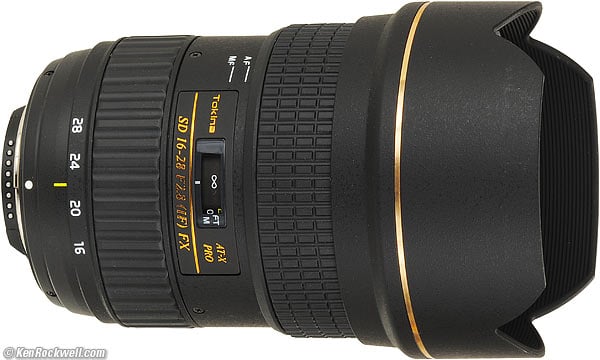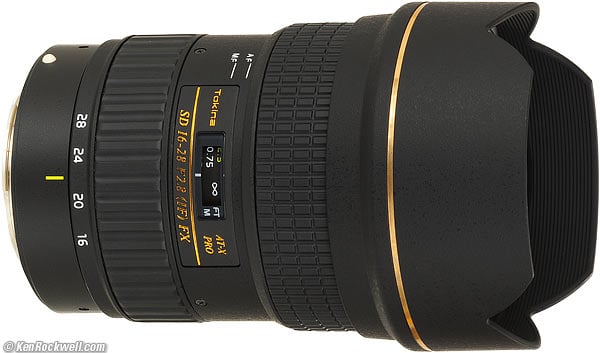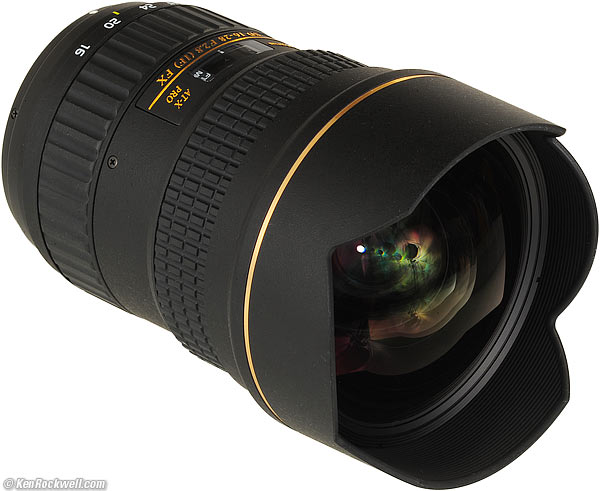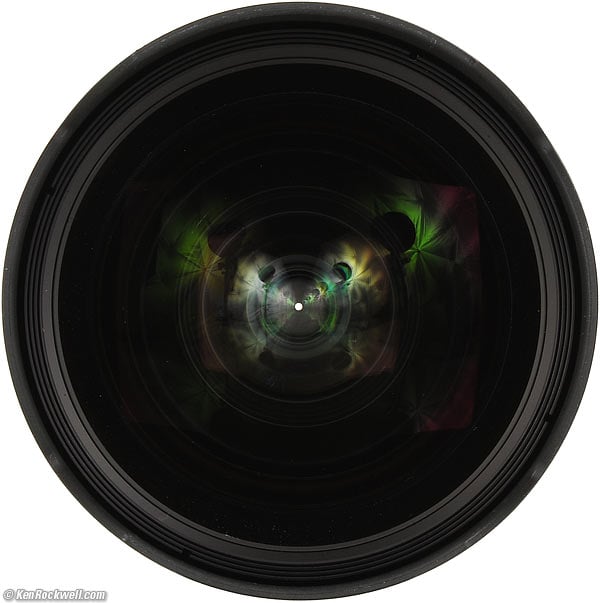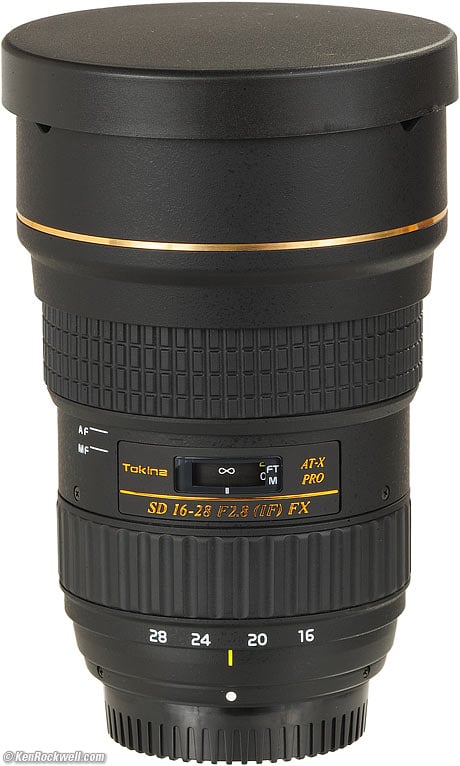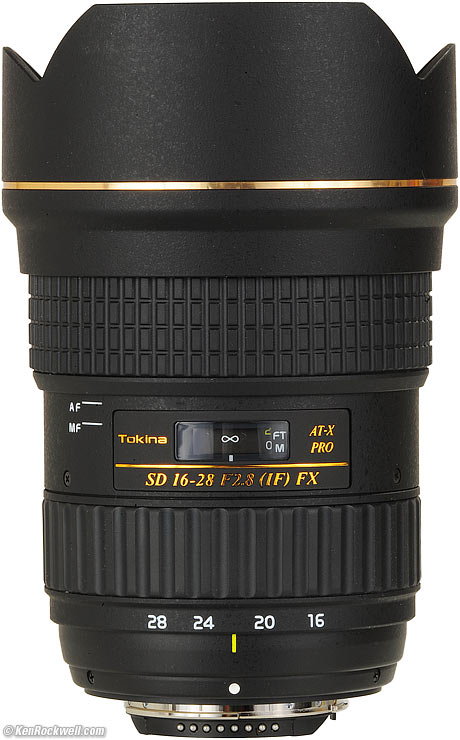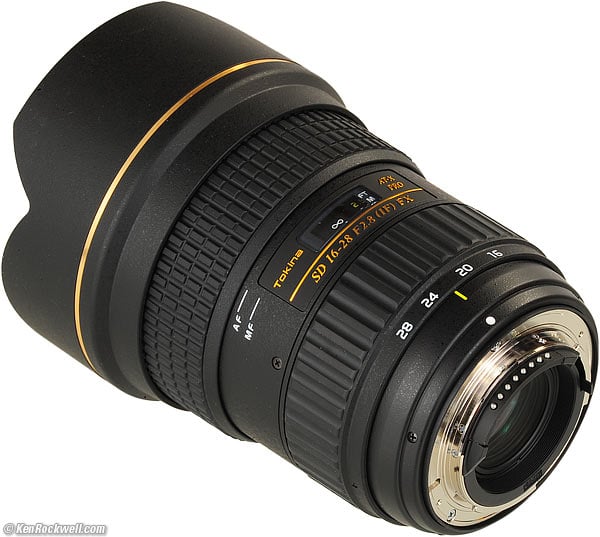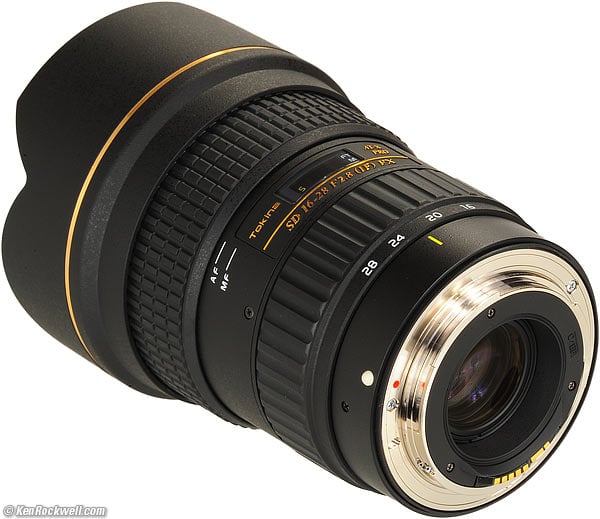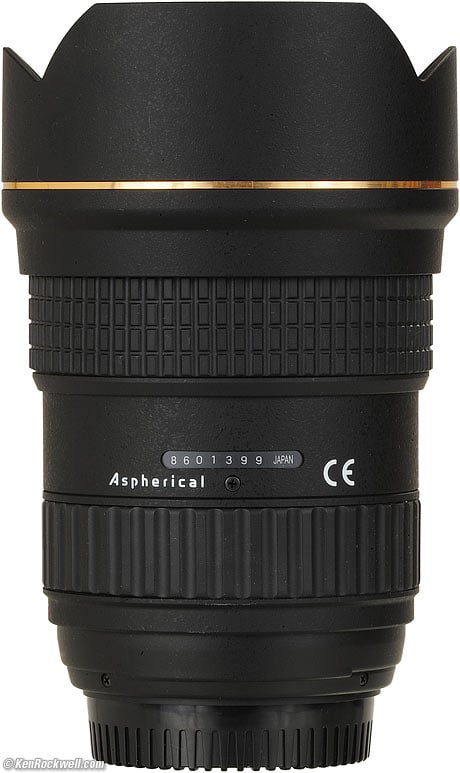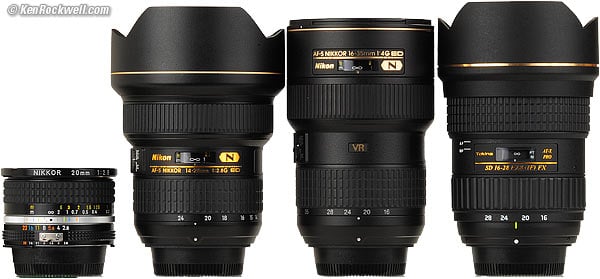Home Donate New Search Gallery Reviews How-To Books Links Workshops About Contact
Tokina 16-28mm f/2.8
AT-X PRO FX (2010- )
© 2011 KenRockwell.com. All rights reserved.
Intro Specs Performance Compared Recommendations
Tokina 16-28mm f/2.8 in Nikon mount (no filters, 33.4 oz./946g, about $549). enlarge. The biggest source of support for this free website is when you use these links, especially directly to it in Nikon mount at Adorama or in Nikon mount at Amazon when you get anything, regardless of the country in which you live. Thank you! Ken.
Tokina 16-28mm f/2.8 in Canon EOS mount (no filters, 33.6 oz./952g), about $549). enlarge. The biggest source of support for this free website is when you use these links, especially directly to it in Canon EOS mount at Adorama or in Canon EOS mount at Amazon when you get anything, regardless of the country in which you live. Thank you! Ken.
March 2018 More Tokina Reviews Other brand reviews
Nikon Reviews Nikon Lenses Canon Reviews Canon Lenses
| Optics: | |
| Mechanics: | |
| Ergonomics: | |
| Usefulness: | |
| Availability: | |
| Overall: |
Ideal Uses: Perfect for use on FX digital as an ultrawide.
Not for: Won't work on manual-focus cameras. Can't use filters, so mostly useless on film. It's foolish to use this on a DX or 1.6x Canon camera; for them, the Tokina 11-16mm, or even a kit lens, is a much smarter idea.
Good: As good optically as Nikon's exotic 14-24mm f/2.8 AF-S, which costs more than twice as much.
Bad: Takes no filters, big and heavy. I prefer the Nikon 16-35mm VR.
Introduction top
Intro Specs Performance Compared Recommendations
Formats and Versions Compatibility
|
I buy only from these approved sources. I can't vouch for ads below. |
This Tokina 16-28mm f/2.8 is as good optically as Nikon's world-changing 14-24mm f/2.8 of 2007, and this Tokina lens costs less than half as much. This Tokina is also as good optically as Canon's 16-35mm f/2.8 L II.
This Tokina's optical performance is exceeded only by Nikon's 16-35mm f/4 VR, which I prefer to either of the Nikon 14-24mm or this Tokina 16-28mm because the Nikon 16-35mm takes filters, and weighs less than either of the f/2.8 lenses.
Both the Nikon 14-24mm and this Tokina 16-28mm are big, heavy lenses, and neither can use any filters. Filters are critical for photography in difficult conditions, as well as for protection, and neither of these lenses can use any filters of any kind. Poo. The Canon 16-35mm f/2.8 L II cheerfully takes 82mm filters.
I always use filters, especially for prophylaxis and grad filters, while less experienced photographers usually do not understand the importance of filters.
If you're considering the big Nikon 14-24mm, by all means get this Tokina instead if price matters. I'd pay the extra for the Canon 16-35mm f/2.8 L II because it takes filters, and is much smaller and lighter than this Tokina.
Formats and Versions intro top
This Tokina 16-28mm f/2.8 comes in both Nikon and Canon EOS mounts. I am addressing the Nikon mount version here; you may make the usual extrapolations for Canon.
This is a full-frame (FX) lens. I will be testing it as such.
It makes no sense to use this beast on the lesser formats; on a D7000 or other small-framer, use any 16-85mm or kit lens for better results with a lot less size and weight and expense.
Nikon Version
Everything should work perfectly on every digital Nikon, both FX and DX, and even on Nikon's cheapest digitals like the D40, D40x, D60, D3000, D3100 or D5000.
It also should be perfect on decent or recent AF film cameras like the F6, F100, F5, N80 and N75.
The incompatibilities for older or cheaper film cameras are that:
1.) It won't autofocus with the cheapest new AF 35mm cameras like the N55, but if you focus manually, everything else should work great. Even if you lose autofocus, these cameras have in-finder focus confirmation dots to help you.
2.) Late 1980s ~ early 1990s AF cameras like the N90s, N70 and F4 should autofocus just fine, but you'll lose Manual and Aperture-priority since you have no way to set the aperture on the camera or on the lens.
3.) You're really pushing it with the oldest AF cameras like the N2020, N6006 and N8008. You'll have no AF, and confused exposure modes. Manual focus is fine, with electronic focus indications.
4.) Since it has no aperture ring, it's just about useless with manual focus film cameras. It will shoot every shot at its minimum aperture.
See Nikon Lens Compatibility for details with your camera. Read down the "AF-S, AF-I," and "G" columns for this lens. You'll get the least of all the features displayed in all columns, since "G" (gelding) is a deliberate handicap which removes features.
Warning: as a non-Nikon and non-Canon lens, there is never any guarantee that this Tokina lens will always work perfectly with every possible camera. I've only used it on the Nikon D3 and D7000. There is always the potential for it not to work on some models of camera, today or newer models in the future. This is the chance you take with non-Nikon or non-Canon lenses.
Tokina 16-28mm f/2.8 FX. enlarge.
Canon Version
The Tokina 16-28mm works fine on my 5D Mark II and my EOS 620 (1987), so that ought to cover it.
Specifications top
Intro Specs Performance Compared Recommendations
Tokina calls this the Tokina AT-X 16-28mm F2.8 PRO FX.
AT-X: Advanced Technology-seX.
PRO: Tokina's designation for its lenses with its brilliant AF-MF focus clutch.
FX: Full-frame 35mm.
IF: Internal focusing.
Tokina claims a "silent DC motor," but that's just a trade name. It most certainly isn't silent.
15 elements in 13 groups.
Three of these are aspherical: one in the front, and two in the back.
Three of these are SD super-low dispersion glass, similar to Nikon's ED glass.
Internal focusing.
Multicoated.
Coverage top
107.1º-76.9º on 35mm and FX.
Less on lesser formats.
Tokina 16-28mm f/2.8 at minimum aperture. enlarge.
9 rounded blades. (Tokina's ads erroneously claim only 8.)
Stops down to f/22.
Focal Length top
16-28mm.
When used on a DX camera, it gives angles of view similar to what a 24-42mm lens gives when used on an FX or 35mm camera.
0.9 feet (0.28m), marked.
Maximum Reproduction Ratio specs top
1:5.26.
Hard Infinity Focus Stop? specs top
Sometimes. The sample seen here stopped at infinity at some focal lengths, but can focus slightly beyond at other focal lengths.
I let the AF system focus for infinity.
Yes, basic.
Depth-of-Field Scale specs top
No.
Infra-Red Focus Index specs top
No.
No.
None.
No.
Tokina specifies 5.25" (133.3mm) long by 3.54 in. (90.0mm) diameter.
Nikon version: 33.380 oz. (946.3g), measured.
Canon version: 33.595 oz. (952.35g), measured.
Tokina specifies 33.5 oz. (950g).
None, use your hand.
The petals you see in front are to keep things from hitting the glass.
None.
Made in Japan.
Serial numbers hand-written on both box and warranty card.
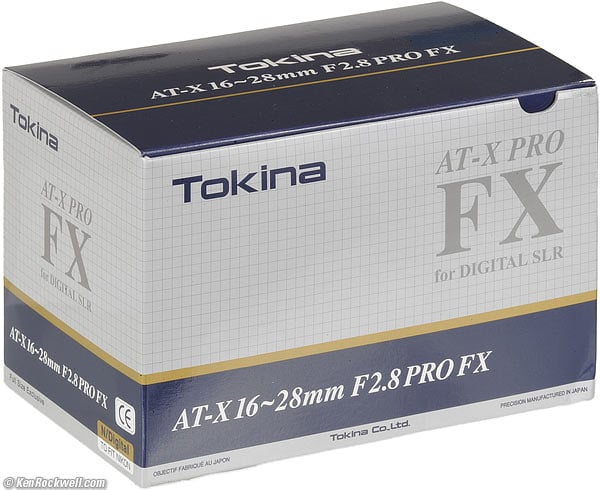
Box, Tokina AT-X 16-28mm f/2.8 FX.
Single-wall cardboard box, glossy printed.
Folded corrugated cardboard formers inside. Lens in clear plastic bag inside cardboard.
Paperwork on top of cardboard, just under box cover.
No instruction manual.
2010.
Early December 2010.
Tokina Product Number specs top
Nikon: AT-X 16-28 PRO FX NAF.
Canon: AT-X 16-28 PRO FX EOS.
Three Years.
$549 for Nikon and for Canon, March 2018.
$850, December 2010.
Performance top
Intro Specs Performance Compared Recommendations
Overall Auto and Manual Focus Bokeh Caps Color Coma
Distortion Ergonomics Eyeblow Falloff Filters Focus Breathing
Color Fringes Mechanics Sharpness Sunstars Survivability
Overall performance top
Nikon
This Tokina 16-28mm f/2.8 FX ATX is as good as Nikon's best equivalent lens, the 14-24mm f/2.8, sometimes better, for half the price.
Personally, I prefer the Nikon 16-35mm VR to either of the f/2.8 lenses, because it's smaller and lighter, and I need to use filters for protection and for dealing with light.
Canon
This Tokina 16-28mm f/2.8 FX ATX is as good optically as Canon's 16-35mm f/2.8 L II, however this Tokina is much bigger and heavier and can't use filters, as the Canon lens can.
Auto and Manual Focus performance top
This Tokina lens has a motor inside to focus itself.
AF Speed
Autofocus is about as fast as the Nikon 14-24mm.
The 20mm f/2.8 AF-D is faster than any of these.
AF Accuracy
AF is fine.
My Nikon D7000 needed some AF Fine Tuning for best results.
It's not perfect, but close enough.
AF Noise
This Tokina has a much noisier AF motor than the Silent Wave Motor of Nikon's lenses.
It is not a Silent Motor as in Canon and Nikon lenses. This Tokina sounds like it has a regular electric motor in it.
Manual Focus
Manual focus is swell, just pull the ring towards you and go!
It turns in the correct direction, something Sigma lenses often do not.
Bokeh performance top
Bokeh is rarely visible with ultrawide lenses, since very few things ever get out-of-focus.
Bokeh is the character of out of focus areas, not simply how far out of focus they are.
If you can see the bokeh, it's pretty bad at f/2.8.
Caps performance top
Capped Tokina 16-28mm f/2.8. enlarge.
The front cap isn't. The front cap is just a short, soft-plastic Tupperware-like thing that doesn't fully cover the front of the lens. It falls right off.
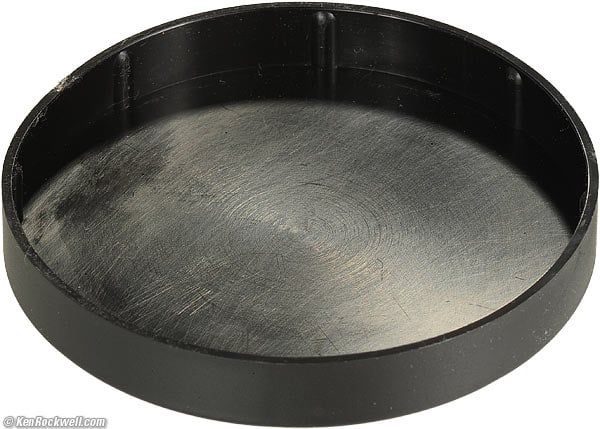
Front cap.
I'd save the front and rear caps for posterity, and replace them with a real Nikon rear cap ($8) and a LensCoat Hoodie Small front neoprene cap ($13).
Color Rendition performance top
Color rendition is somewhat warmer than my NIKKOR lenses and warmer than the Canon 16-35mm f/2.8 L II.
Coma performance top
There is almost no coma wide-open. Coma would be weird smeared blobs that appear around bright points of light in the corners. See also sagittal coma flare.
Distortion performance top
The Tokina 16-28mm f/2.8 FX has moderate barrel distortion at 16mm, and no visible distortion from 20mm through 28mm.
For critical use, plug these figures into Photoshop's lens distortion filter. These aren't facts or specifications, they are the results of my research that requires hours of photography and calculations on the resulting data.
FX and Film at 3m (10') |
|
16mm |
+3.0 |
20mm |
+1.0 |
24mm |
0.0 |
28mm |
-0.5 |
© 2010 KenRockwell.com. All rights reserved.
Ergonomics performance top
Tokina 16-28mm f/2.8 FX. enlarge.
Ergonomics are mostly swell, with the two big gotchas of no way to use filters, and that this is a big, heavy lens.
The metal used for the mount often hangs-up or grinds in my Nikons; it's not a smooth slide-in as with Nikon's lenses.
In AF, turning the big, fat focus ring does nothing, so you can get a good, solid grip on it without affecting AF. Nothing moves on the barrel as it autofocuses.
To get manual focus, simply pull the focus ring towards you, and it clicks into manual focus mode. Now turn the rubber-covered metal focus ring for easy manual focus.
Eyeblow performance top
As zoom lenses zoom in and out, air pumps in and out, and can blow out of a camera eyepiece.
The Nikon 14-24mm has a lot of eyeblow, while this Tokina has very little. This means sensors and cameras will stay cleaner than with the Nikon lens.
Falloff (darkened corners) performance top
Falloff on FX is visible wide open, and then it goes away.
It will be even less of an issue on DX (see crop factor).
I've exaggerated this by shooting a gray field and placing these on a gray background.
Tokina 16-28mm f/2.8 FX falloff on FX and film, no correction, Nikon.
© 2010 KenRockwell.com. All rights reserved.
|
Filters, Use with performance top
Forget it!
There's no reasonable way to attach filters to the front or to the rear.
Focus Breathing performance top
Of interest mostly to cinematographers focusing back and forth between two subjects, for instance, a couple having a conversation, the image from the Tokina 16-28 2.8 gets slightly smaller as focused more closely.
Lateral Color Fringes performance top
Nikon
There are no lateral color fringes on the D3 or the D7000, which correct them automatically.
Canon
There are only the slightest magenta fringes when shot on the Canon 5D Mark II. Oddly, they are the same at all focal lengths, maybe a bit less at 28mm.
Mechanics performance top
Tokina 16-28mm f/2.8, Nikon mount. enlarge.
Tokina 16-28mm f/2.8, Canon mount. enlarge.
This Tokina is a tough, well-made lens. My biggest complaint is the rear mount, which grinds when mounted and unmounted.
Front Protective Blades (faux hood)
Heavy plastic.
Filter Threads
None.
Fore Barrel
Plastic.
Focus Ring
Metal; rubber covered.
Mid and Aft Barrel Exterior
Plastic.
Zoom Ring
Plastic; rubber covered.
Internals
Seem like metal.
Mount
Light-gold-colored metal.
Sometimes sticky or gritty when mounting, not always smooth like Nikon's lenses.
Markings
Paint.
Identity Plate
Black and gold debossed metal plate, with clear plastic window for focus scale.
Serial Number
Bottom, Tokina 16-28mm f/2.8 FX. enlarge.
Serial number is printed on a glued-on sticker on the bottom rear of barrel
Ass-Gasket (rain seal at mount)
Yes.
Noises When Shaken
Lots of clicking, and the front group flops around a bit, too.
Made in
Japan.
Sharpness performance top
Warning 1: Image sharpness depends more on you than your lens.
Warning 2: Lens sharpness doesn't mean much to good photographers.
The Tokina 16-28mm f/2.8 is sharp. It's as sharp as Nikon's 14-24mm f/2.8 G AF-S, which costs more than twice as much, and as sharp as Canon's 16-35mm f/2.8 L II.
It's not as sharp as Nikon's 16-35mm VR; no other SLR zoom lens is, either.
Sharpness on a 12MP FX Nikon D3
16mm
The center is always sharp.
The sides are a bit softer at f/2.8, and improve greatly at f/4 and f/5.6, optimum at f/8.
20mm
The center is always sharp.
The corners are sharp, but a bit softer at f/2.8. They get even better at f/4 and f/5.6, optimum at f/8.
24mm
The center is always sharp, but a bit less contrasty at f/2.8.
The corners are sharp, but a bit softer at f/2.8. They get even better at f/4 and f/5.6, optimum at f/8.
28mm
The center is always sharp, but a bit less contrasty at f/2.8.
The corners are sharp, but a bit less contrasty at f/2.8. They get even better at f/4 and f/5.6, optimum at f/8.
Sharpness on a 16MP DX Nikon D7000
At larger apertures, there is still some classic "Tokina glow," meaning a sharp image core contained inside a halo of lower contrast.
It's super-sharp stopped down.
Sharpness on a 21MP Canon 5D Mark II
It's about the same as Canon's 16-35mm f/2.8 L II: very soft in the corners wide-open at 16mm, improving greatly in the center or with stopping down.
Sunstars performance top
With its often circular curved 9-bladed diaphragm, this Tokina 16-28 makes muted 18-pointed sunstars, if any at all.
Survivability performance top
The Tokina 16-28mm f/2.8 seems pretty tough, so long as you don't bash the unprotected glass in the front of the lens.
The AF motor can die, and I'm unsure how much luck you'll have getting it serviced in 20 or 30 years.
Compared top
Intro Specs Performance Compared Recommendations
Nikon 20/2.8 AI-s, 14-24mm, 16-35mm and Tokina 16-28mm f/2.8 FX. enlarge.
Table of Current for-Nikon Ultrawides
Tokina 16-28 |
|||||
| Introduced | 1984 |
1989 |
2007 |
2010 |
2010 |
| Maximum Aperture | f/2.8 |
f/2.8 |
f/2.8 |
f/4 |
f/2.8 |
| Vibration Reduction | no |
no |
no |
Yes |
no |
| Use protection filters? | Yes |
Yes |
no |
Yes |
no |
| Use grad filters? | Yes |
Yes |
no |
Yes |
no |
| Filter Size | 62mm |
62mm |
none |
77mm |
none |
| Filter Threads | Metal |
plastic |
none |
plastic |
none |
| Build Quality | Pro |
Amateur |
Near-pro |
Amateur |
Near-pro |
| Barrel | Metal |
plastic |
Metal and plastic |
plastic |
plastic |
| Mount | Metal |
Metal |
Metal |
Metal |
Metal |
| OK on manual-focus cameras? | Yes |
Yes |
no |
no |
no |
| OK on DSLRs? | Yes |
Yes |
Yes |
Yes |
Yes |
| Diaphragm Blades | 7 |
7 |
9 |
9 |
9 |
| Focus | Manual |
AF-D |
AF-S |
AF-S |
AF |
| Instant manual-focus override? | Yes |
no |
Yes |
Yes |
|
| Focus Scale | Yes |
Yes |
Yes |
Yes |
Yes |
| Depth-of-field scale | Yes |
Yes |
no |
no |
no |
| Infra-red index | Yes |
Yes |
no |
no |
no |
| Close Focus | 0.25m |
0.25m |
0.28m |
0.28m |
0.28m |
| Maximum Repro Ratio | 1:8.3 |
1:8.3 |
1:6.7 |
1:4 |
1:5.26 |
| Weight | 259g |
255g |
1,000g |
678g |
946g |
| Made in | Japan |
Japan |
Japan |
Thailand |
Japan |
| Price, 12/2010 |
Table of for-Canon Ultrawides top
Tokina 16-28 |
|||||
| Introduced | c. 1989 |
2003 |
2001 |
2007 |
2010 |
| Maximum Aperture | f/2.8 |
f/4 |
f/2.8 |
f/2.8 |
f/2.8 |
| Use protection filters? | Yes |
Yes |
Yes |
Yes |
no |
| Use grad filters? | Yes |
Yes |
Yes |
Yes |
no |
| Filter Size | 72mm |
77mm |
77mm |
82mm |
none |
| Filter Threads | plastic |
Metal |
Metal |
none |
|
| Build Quality | Near-pro |
Near-pro |
Near-pro |
Near-pro |
Near-pro |
| Barrel | plastic |
plastic |
plastic |
plastic |
|
| Mount | Metal |
Metal |
Metal |
Metal |
Metal |
| OK on manual-focus FD cameras? | no |
no |
no |
no |
no |
| OK on DSLRs? | Yes |
Yes |
Yes |
Yes |
Yes |
| Diaphragm Blades | 7 |
7 |
7 |
9 |
|
| Focus | USM |
USM |
USM |
USM |
AF |
| Instant manual-focus override? | Yes |
Yes |
Yes |
Yes |
clutch |
| Focus Scale | Yes |
Yes |
Yes |
Yes |
Yes |
| Depth-of-field scale | Yes |
no |
no |
no |
no |
| Infra-red index | Yes |
Yes |
Yes |
Yes |
no |
| Close Focus | 0.25m |
0.28m |
0.28m |
0.28m |
0.28m |
| Maximum Repro Ratio | 1:5.26 |
||||
| Weight | 405g |
474g |
599g |
634g |
946g |
| Made in | Japan |
Japan |
Japan |
Japan |
|
| Price, 01/2011 | used. |
Sharpness Compared: Nikon top
I compared this Tokina directly against the Nikon 20/2.8 AI-s, Nikon 14-24mm and Nikon 16-35mm VR at the range on a 12MP DX Nikon D3. The Nikon 20/2.8 AI-s is optically identical to the Nikon 20mm f/2.8 AF-D.
As expected, the Nikon 16-35mm VR is superior to the other three. I won't mention it below for the sake of simplicity, thus except at 20mm, I'm only writing about the differences between the Nikon 14-24mm and this Tokina.
At 16mm
At f/2.8, the Nikon 14-24mm is a hair sharper in the sides and corners.
At f/4, the Tokina is better throughout most of the frame.
At f/5.6, the Tokina is very slightly better throughout the frame.
At f/8, it's too close to call.
At 20mm
At f/2.8, the 20mm f/2.8 AI-s is the softest, and this Tokina is the sharpest; superior to Nikon's exotic 14-24mm.
At f/4, this Tokina is again the best, followed by the Nikon 14-24mm and then the Nikon 20/2.8 AI-s.
At f/5.6, we have the same order, however this Tokina and Nikon 14-24mm are very close.
By f/8, it's too close to call.
At 24mm
At f/2.8, the Nikon has a little less resolution than the Tokina, but the Tokina has a little less contrast due to the Tokina glow (veiling haze over a sharper core).
At f/4, the Tokina glow is gone, and this Tokina is superior to the Nikon 14-24mm.
At f/5.6, it's getting closer, and the Tokina is still superior.
At f/8, the Tokina is sharper than the Nikon 14-24mm.
Sharpness Compared: Canon top
I compared this Tokina directly against the Canon 16-35mm f/2.8 L II. They are about the same; which is better varies as you change focal length, aperture and where you look in the field.
Distortion Compared: Canon top
The Tokina has a little less distortion, and more importantly, the Tokina's distortion is simple and easy to correct in Photoshop, while the Canon 16-35mm f/2.8 L II's distortion is complex and will need a more advanced tool, like DxO, to correct completely.
Ghosts Compared top
Here's the same shot on Nikon FX, f/8 and 1/250 at ISO 200:
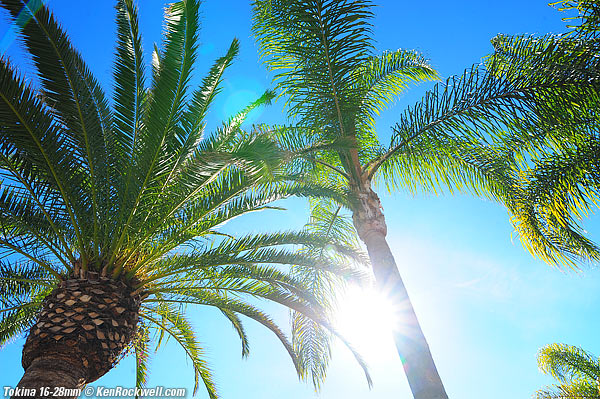
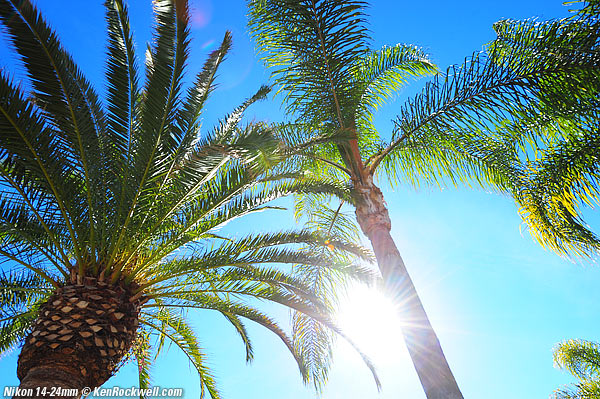
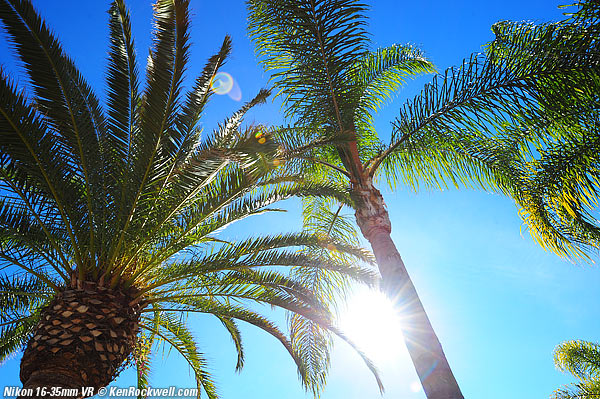
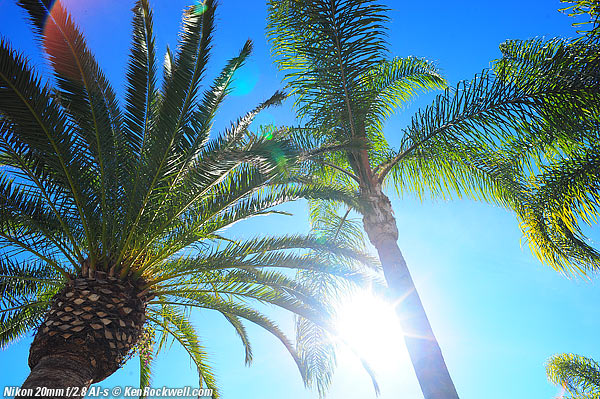
Even with all the Nano-coating marketing BS of the two AF Nikkors, I don't see any differences great enough to worry about. Change the focal lengths or move the camera, and the ghosts moves around, making different lenses look better or worse.
Recommendations top
Intro Specs Performance Compared Recommendations
This is easy!
Nikon
This Tokina 16-28mm f/2.8 FX is as good as the Nikon 14-24mm f/2.8 G AF-S, for less than half the price. If you were considering the Nikon 14-24mm, but were wavering because of the price, yes, go ahead and get this Tokina.
If you're considering it for Canon, give me a week and I ought to have a read on it versus the Canon ultrawide zooms. I am expecting that this Tokina will be optically superior to any Canon ultrawide zoom, L or otherwise.
Personally, I haven't used my Nikon 14-24mm ever since the superior Nikon 16-35mm VR came out. It's smaller, lighter, takes filters, is sharper, and adds VR, so my 14-24mm is in my box of items to donate to the Salvation Army. This Tokina is the same as the Nikon 14-24mm, so having the Nikon 16-35mm VR, this Tokina doesn't excite me. It would have before 2010, but not any more.
The Nikon 16-35mm VR costs a bit more than this Tokina, but I wouldn't let that stop me. Unlike cameras, you'll easily be using your lenses for the next ten or twenty years on whatever new cameras come out, so a few hundred dollars spent today to get what you really want is always a good idea. Never deny yourself the lenses you want.
Don't worry about 14mm versus 16mm.They are the same thing. I'd worry more about how 35mm can be much more useful than 24mm or 28mm.
I'd pitch Tokina's caps, and replace them with a real Nikon rear cap ($8) and a LensCoat Hoodie small neoprene front cap ($13).
Canon
With Canon, our choices aren't so clear.
Canon's 16-35mm f/2.8 L II is a much lighter lens with a broader zoom range in a smaller package that also takes filters.
As a Canon shooter, size, weight and the ability to use filters are very important to me, so I'd pass on this Tokina and save for the Canon 16-35mm II. It is always a good idea to spend what you want on lenses, since they will serve you for years to come.
I'd pitch Tokina's caps, and replace them with a real Canon rear cap ($7) and a LensCoat Hoodie small neoprene front cap ($13).
More Information
Help me help you top
I support my growing family through this website, as crazy as it might seem.
The biggest help is when you use any of these links to Adorama, Amazon, eBay, Ritz, Calumet, J&R and ScanCafe when you get anything, regardless of the country in which you live. It costs you nothing, and is this site's, and thus my family's, biggest source of support. These places have the best prices and service, which is why I've used them since before this website existed. I recommend them all personally.
If you find this page as helpful as a book you might have had to buy or a workshop you may have had to take, feel free to help me continue helping everyone.
If you've gotten your gear through one of my links or helped otherwise, you're family. It's great people like you who allow me to keep adding to this site full-time. Thanks!
If you haven't helped yet, please do, and consider helping me with a gift of $5.00.
As this page is copyrighted and formally registered, it is unlawful to make copies, especially in the form of printouts for personal use. If you wish to make a printout for personal use, you are granted one-time permission only if you PayPal me $5.00 per printout or part thereof. Thank you!
Thanks for reading!
Mr. & Mrs. Ken Rockwell, Ryan and Katie.
Home Donate New Search Gallery Reviews How-To Books Links Workshops About Contact

